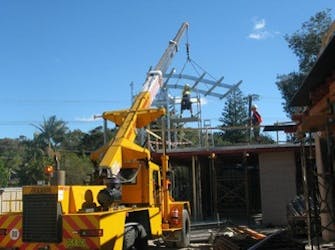Building Innovation and Eco Design Concepts
Click here to view information in regards the Advanced Eco Design.
Building Design Innovation for a new world environment, Sun Worship is a development based on sustainable practices bringing together many different innovative concepts into a unique development of five villas. The innovation concepts include:
Rammed Earth gives unmatched thermal insulation properties and is an ancient and raw building technique gaining favour in the modern world. The colours are from the earth and no painting is required. Combined with both the upper and lower Concrete Slabs gives the building large mass providing passive heating and cooling properties. The Rammed Earth consists of 92% sandstone and 8% cement. The earth material is sub road base sourced from Bonny Hills Quarry near Port Macquarie. The material has a very low environmental impact compared to other materials as there is no production cost other than the ramming.
Polycarbonate is one of the most modern building materials available that has a range of light and heat transmission properties available dependent on the usage required. The Polycarbonate used comes from Danpalon and is sourced from Israel. The material is 100% recyclable. It has recycled content within production of the material.
Water is collected from the roof of all villas and fed back into a 35,000 litre tank which is pumped back to all villas to be used in toilets and garden water.
Solar Orientation - Every villa on the development is orientated to make the most efficient use of the daily sun for heating and light. The orientation is calculated for the latitude and longitude that the villas are located in.
Solar Eves - The length of the eves are calculated to allow sun to penetrate into the rooms during winter and blocks sun during summer.
Solar Water Heating - The Apricus Solar Water Heating tubes are used to heat the water used throughout the building. The slope of the roof and orientation of the building provide the optimum orientation for the solar water heater.
Ventilation - The Solar Chimney allows hot air to rise and draw air through the building. Vents are located around the base of the building to allow air to enter the building. The vents are shut in winter and the thermal properties of the polycarbonate and correct solar orientation allow the building to capture heat.
Grasscrete - The Driveways are paved with grasscrete. Forms are used in the concrete pour to allow for drainage channels through the concrete. Grass is grown in these voids. This technique reduces water runoff from the driveway to a minimum and gives a more natural and green look to the development. Source: Enviro Concrete
Electricity - Generation Solar Energy is generated from panels located on the roof. The power is fed back into the grid from all Villas. The balance of electricity use within the villas and energy produced used should be close to neutral. Conservation Lighting within the building is generated from LED and new generation fluorescent lighting. Cooking is completed using gas stoves and the barbecue. Passive Heating and Cooling of the house comes from design of the building. Washing Machines, Fridges and Dishwashers are all selected for maximum efficiency in water and electricity use.
Eco Friendly Materials:
Concrete is the 3rd Biggest Polluter of CO2 in the world. Green Cement was sourced for the project but local delivery was not possible. Green Cement is produced from China Clay rather than Calcium Carbonate. Stone in floors were sourced from Nambucca.
The Metal Cladding material comes from BlueScope which is sourced within Australia. The material has a high environmental cost to produce but but is 100% recyclable. The Structural Steel is sourced from within Australia.
Structural Wood is Pine and sourced from Sustainable Pine Forests within Australia. Hardwood is sourced locally from Macleay Valley Hardwood. Bamboo is sourced from Bali however we are currently investigating local supply.
Insulation is sourced from Higgins in Brisbane. Insulation is made from Plastic Milk Bottles and other types of recycled materials
Glass is sourced from Viridian which is located in Dandenong Victoria. Viridian have recently upgraded their furnace to comply with better environmental standards.
Aluminum is sourced from Capral in Bundamba Australia.
Capral have a strong environmental stance in the production of aluminum products.
Internal cladding other than rammed earth surfaces have been kept to a minimum. Gyprock has been used for cladding which has a low environmental impact. Paint has a high environmental impact. Painted surfaces are minimal throughout the building both externally and Internally. Paints and Sealants have been chosen for their lower environmental impact.



